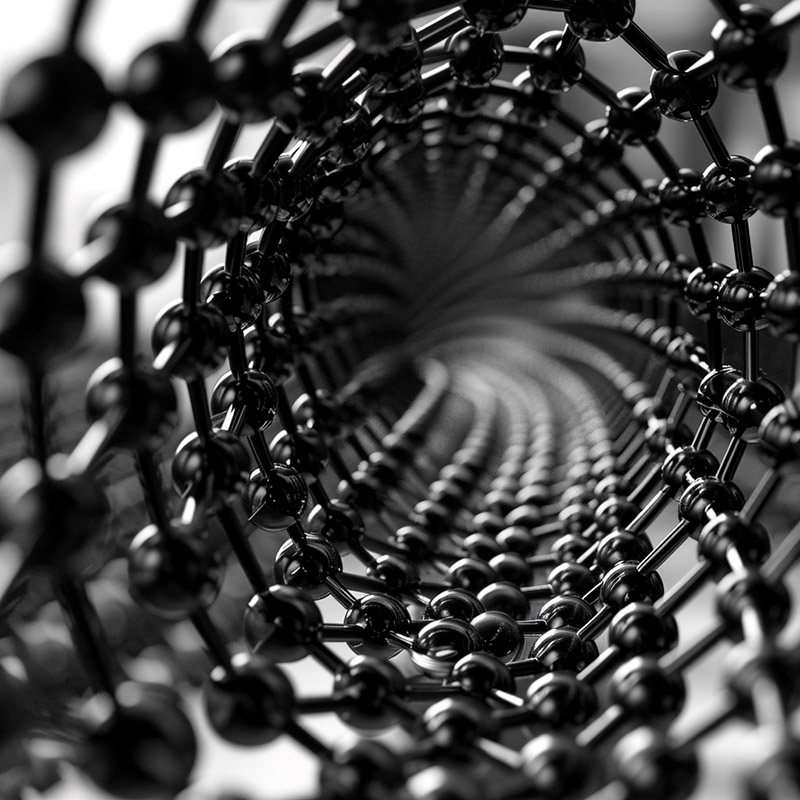
Carbon nanotubes (CNTs) are allotropes of carbon with a cylindrical nanostructure.
- Formed by rolling up graphene sheets into tube-like structures with diameters of about 1-50 nm
- Length ranging from less than a micron to several centimeters
- Extremely high tensile strength, electrical and thermal conductivity
- Can be single-walled (one cylinder) or multi-walled (concentric cylinders)
- Semiconducting or metallic depending on molecular structure
- Made via techniques like arc discharge, laser ablation and chemical vapor deposition
- Used to strengthen composites, in field emitters, water filters, batteries and for nanoelectronics
Carbon nanotubes are tubular nano-forms of carbon with remarkable physical properties, with innovative applications across electronics, materials science and energy sectors.
 Carbon nanotubes, recently created cylinders of tightly bonded carbon atoms, have dazzled scientists and engineers with their seemingly endless list of special abilities--from incredible tensile strength to revolutionizing computer chips. In the September 2003 issue of Science, two University of Rochester researchers add another feat to the nanotubes' list: ideal photon emission.
Carbon nanotubes, recently created cylinders of tightly bonded carbon atoms, have dazzled scientists and engineers with their seemingly endless list of special abilities--from incredible tensile strength to revolutionizing computer chips. In the September 2003 issue of Science, two University of Rochester researchers add another feat to the nanotubes' list: ideal photon emission.
"The emission bandwidth is as narrow as you can get at room temperature," says Lukas Novotny, professor of optics at Rochester and co-author of the study. Such a narrow and steady emission can make such fields as quantum cryptography and single-molecule sensors a practical reality.
The emission profile came as a surprise to Todd Krauss, assistant professor of chemistry at the University, and Novotny. They had set out to simply define the emission, or fluorescence, of a single carbon nanotube. By using a technique called confocal microscopy, the team illuminated a single nanotube with a strongly focused laser beam. The tube absorbed the light from the laser and then re-emitted light at new frequencies that carried information about the tube's physical characteristics and its surroundings.
The light emitted from the nanotube was in precise, discrete wavelengths, unlike most objects like molecules that radiate into a broader (i.e. more "fuzzy") range of wavelengths at room temperature.
But a greater surprise was in store for the team.
"The emission wasn't just perfectly narrow, it was steady as far as we could measure," says Krauss. In a strange quirk of quantum physics, molecules usually emit their photons for a certain time and then cease, only to resume again later, like a telegraph signal. The tubes that Krauss and Novotny measured, however, remained steady beacons to the limits of their instruments' sensitivity. "This is very exciting because for any application in quantum optics, you want a steady and precise photon emitter," says Novotny.
Narrow emissions and a complete absence of blinking have tempting implications for single photon emitters--devices needed to dependably release a single photon on command. The U.S. Department of Defense is very interested in developing quantum cryptography, a theoretically unbreakable method of coding information, which necessitates a reliable way to deliver single photons on demand.
Other applications come in the form of sensors so sensitive they can detect a single molecule of a substance. For example, when a biological molecule such as a protein binds to a nanotube, the nanotube's perfect emission changes, revealing the presence and characteristics of the molecule. Detecting the change would be impossible if it weren't for the remarkably steady nature of the nanotube emission, because a researcher wouldn't know for certain if a sudden change in the emission was just a blink, or was meant to indicate the presence of the target molecule.
Until just a few months ago, determining the emission characteristics of a nanotube was impossible. Carbon nanotubes cannot be made individually-rather they come as a jumble like a pile of spaghetti. Trying to measure the photon emission of a tube in the jumble is impossible because the tube will pass the photons it absorbs to other tubes instead of re-emitting them in its telltale fashion. What scientists end up with is a sort of average of what the collection of tubes will emit--not the emission characteristics of a single tube. Only within the past few months have researchers figured out how to remove a single nanotube from the pile of spaghetti in order to study its properties as an individual.
Krauss and Novotny are now devising experiments to test the steadiness of the nanotube fluorescence beyond the range of the initial experiments, and are pursuing studies aimed at determining the ultimate minimum possible emission bandwidth at ultracold temperatures.
This work was funded by the National Science Foundation, the U.S. Department of Energy, the Research Corporation, and the New York State Office of Science and Academic Research.